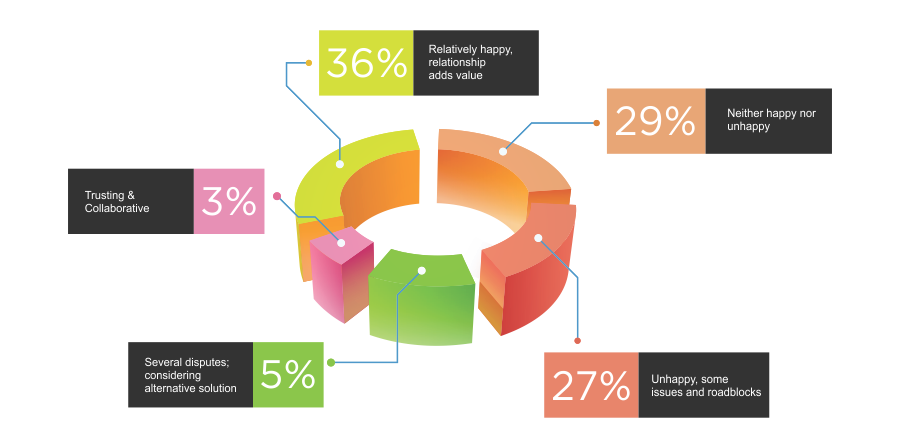Audrey Cushing, Chief of Staff, covers fostering successful outsourcing relationships in her white paper. Audrey discusses how coaching strategies such as active listening and asking powerful questions make clients feel valued and heard.
Please click on the video to the right to learn more about the author, her motivation for writing this white paper, and the impact of positive outsourcing relationships.
To discuss this white paper in detail, please contact Audrey using her information provided at the bottom of the page.

If these nine circles were printed on a piece of paper, could you link all nine by drawing just four straight lines? The catch? Your pen may not leave the paper. Each line starts where the last line finishes.

If you are like most of us, it was not easy to solve this problem and you probably are feeling frustrated. What prevented you from solving this puzzle? Would you believe it was an imaginary box that you, without knowing it, placed around the dots? Connecting the dots within the lines of this “box” is just impossible to do.

Now try removing the imaginary box and extend your pen just beyond the dots and connect them. Much easier, right?! You may decide this is an unfair challenge because you were not informed that you could move your pen outside of the box. That’s fair, but the instructions also failed to say you could not go outside the box.
This puzzle dates to 1914 and continues to challenge us to literally “think outside the box.” Creative thinking puzzles are leveraged by executive coaches to encourage individuals to broaden their thinking by overcoming self-limiting beliefs, often ones that we are not aware that we have. These types of beliefs hold us back and prevent us from achieving our capabilities. An open mind, removed from self-limiting beliefs, makes it possible to consider more solutions when problem-solving.
The objective of this white paper is to share key coaching skills that will generate “outside the box” thinking in relation to how you approach your outsourcing relationships. Fundamentals such as active listening and the art of powerful questioning will be discussed so these techniques can be leveraged to create solid, “happy,” and long-lasting outsourcing relationships.
In 2019, outsourcing advisory firm, ISG conducted a happiness study that revealed 61% of outsourcing relationships are at risk, with 29% classified as neither happy nor unhappy, and a whopping 32% categorized as troubled (see Exhibit 1). Eye-opening for sure. Poor communication between buyers and outsourcing providers are the major contributor to these results. ISG found that “happy” relationships are built on trust and collaboration. This does not come as a surprise, as outsourcing relationships involve a high degree of human interaction.
Coaches are engaged by their clients to generate new ideas, encourage forward action, problem-solve, and support change. Sound intriguing? It should, since these are also the key elements to a healthy outsourcing relationship.
When outsourcing relationships are happy and trusting, ISG reports that it is due to the effort of both the buyer and provider. Both parties invest equally to be able to get the most out of the relationship.

Effective coaches demonstrate empathy and are good at creating relationships, including building rapport. These coaches have developed effective communication skills, practice active listening, and are trained to ask powerful questions. They demonstrate sincere interest in what is being shared.
Active listening assists in creating strong relationships and, while it may not come naturally to many of us, it is an invaluable communication skill. Try reading this exercise to a co-worker and see what happens:
Pretend for a moment you are a bus driver. It is your job to drive the Main Street bus. One day, while on the bus you start to count passengers. At the first stop five people get on your bus. At the next stop, three people get on and two get off. At the next stop, two people get off the bus. At the next stop, three people get on and one person gets off. Here is the question: What color are the eyes of the bus driver?


How did it go? A whopping 87% of people fail this activity, and most fail to get it right even the second time. The quality of our listening is dependent on our interest in what is being said. Instead of listening to understand, we listen with the intent to respond, just waiting for the speaker to take a breath or pause for a moment so we can get our turn to speak. Asking the color of the bus driver’s eyes catches most people off guard because they are so focused on the number of people getting on and off the bus.
Visualize a spring-loaded stack of plates, one that you would see in a large cafeteria. As you take the top plate, the next one rises to the top. Each plate represents an idea or notation that rises into the consciousness of the other person.
As a thought enters the consciousness, it is passed on to the listener and a space for the next thought is created. And the next thought is passed on, and the next. Somewhere down in that stack of plates is a solution, a creative idea, the person’s insight that is waiting to rise to the surface.
Now, imagine your next conversation with your outsourcing counterpart. You are craving innovation or want to problem-solve the outsourcing engagement. You take time to really listen, handing the speaker back their plates (which acknowledges their thoughts); you then add a few of your own “plates” and the interaction continues. Following this process, the advice and insight you are seeking from your outsourcing partner will surface. You are allowing the discussion to advance to a different level.
Questions are essential for improving a meeting’s effectiveness. By asking powerful questions, it compels you to really listen, opening your mind to understand what is being communicated, versus assuming what the answer will be. Leveraging these types of questions during a conversation signals to your outsourcing partner that you are actively participating in a discussion.
This next brain teaser illustrates the value of powerful questioning and how we tend to form questions based on what we assume an answer will be, limiting our power to comprehend fully what is being communicated.
A woman walks into a hardware store. She can buy 6 for $5, 12 for $12, or 24 for $12. What questions would you need to ask to determine what she is buying? Most of you probably want to ask: “Is the item made of metal?” or “Is it a buy one, get one free offer (BOGO)?” or even “Do you use the item to attach something, like a screw or a nail?” Why these questions? We are quick to form solutions in our minds and then create questions to validate what we believe to be true. For example, if you thought she was buying a ruler, you would have wanted to ask, “Does the item have anything to do with measuring?” This does not promote problem-solving because forming a solution so early closes off the mind to explore other options.
So, how do we stop doing this? Before asking a question, pause for a moment and ask yourself, “What assumptions am I making at the moment?” and “What do I believe to be true?” A logical question sequence would be as follows:
Question: “Does 48 cost $12?”
Answer: “Yes”
Question: “Does 96 cost $12?”
Final hint: “Yes, and 97 costs $12, 98 costs $12, but 100 does not cost $12.”
So, what’s the item being purchased? Quite simply, house numbers. Each single house number costs $6. If she resides at 100 Main Street, she would pay $18 for the three numbers versus 55 Main Street at a cost of $12. Probably quite different than your original assumption.
Powerful questions communicate respect and effectively challenge assumptions that limit. Asking questions of your sourcing partner builds trust and demonstrates your interest in their opinion. Powerful questions are:
1. Open ended. Close-ended questions yield little more than a “Yes” or “No” response and do not lead to any type of dialogue. Take note of how often you use them with your outsourcing partner and purposely shift to questions that start with “What” and “How” to open a conversation of exploration and understanding. Open-ended questions require the respondent to elaborate and share information.
2. Advice free. Beware of disguising your advice in a question. Examples include “Have you tried” or “What if you….” or “Why don’t you…” The response from your outsourcing partner will rarely be “Why didn’t I think of that?”
3. Short and simple. The most powerful questions are often the shortest. Do not agonize over how to word a question? Just be curious and really listen to what the other person is saying. The question will come to mind.
4. Forward-focused. Avoid getting caught up in replaying and rehashing the past. Thinking about the future is exciting, and everyone enjoys focusing on new points.
5. Not beginning with “why.” “Why” questions tend to put the person in a position of feeling they need to defend themselves. These types of questions trigger a “threat response.” If you catch yourself forming a “Why” question, rephrase it from, “Why did you do that?” to “What are you hoping to gain?” Notice the difference?